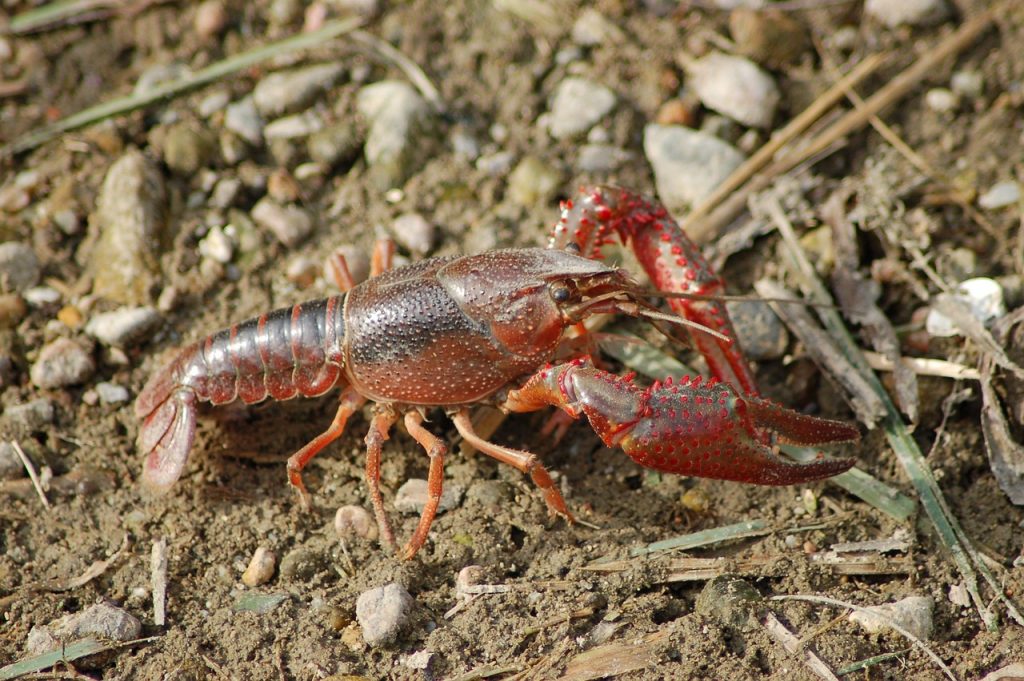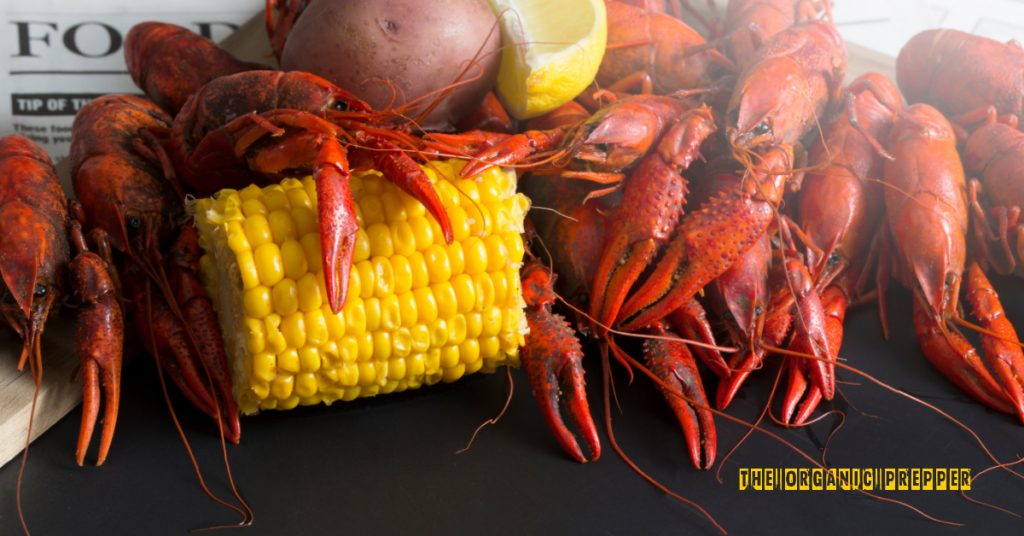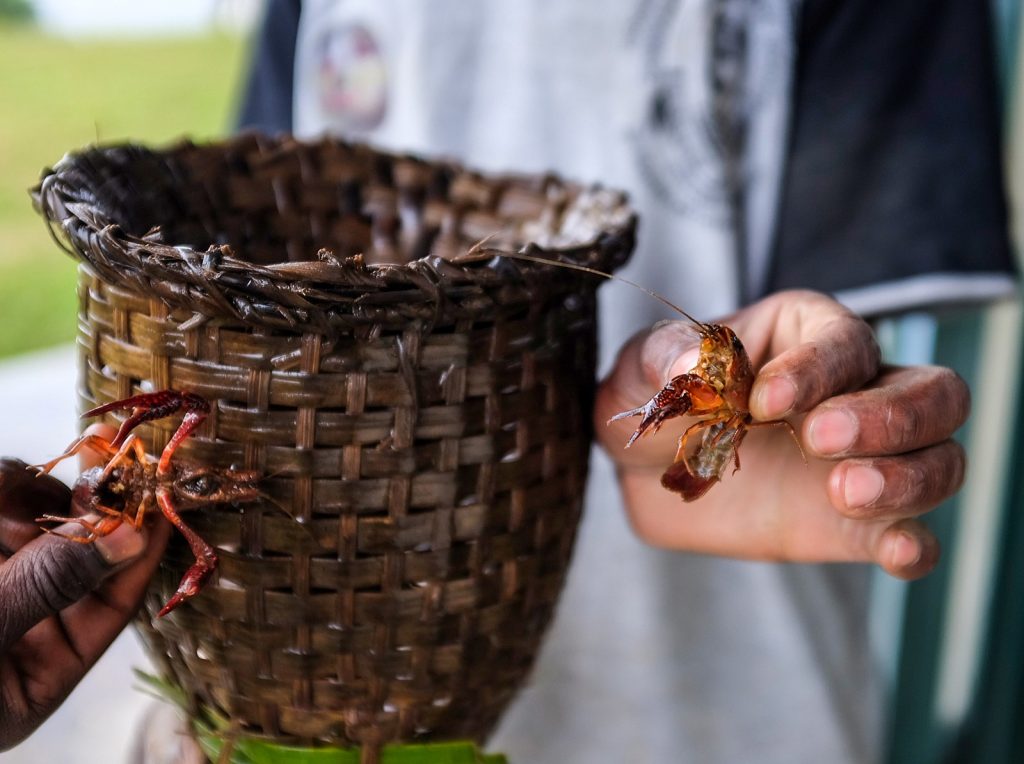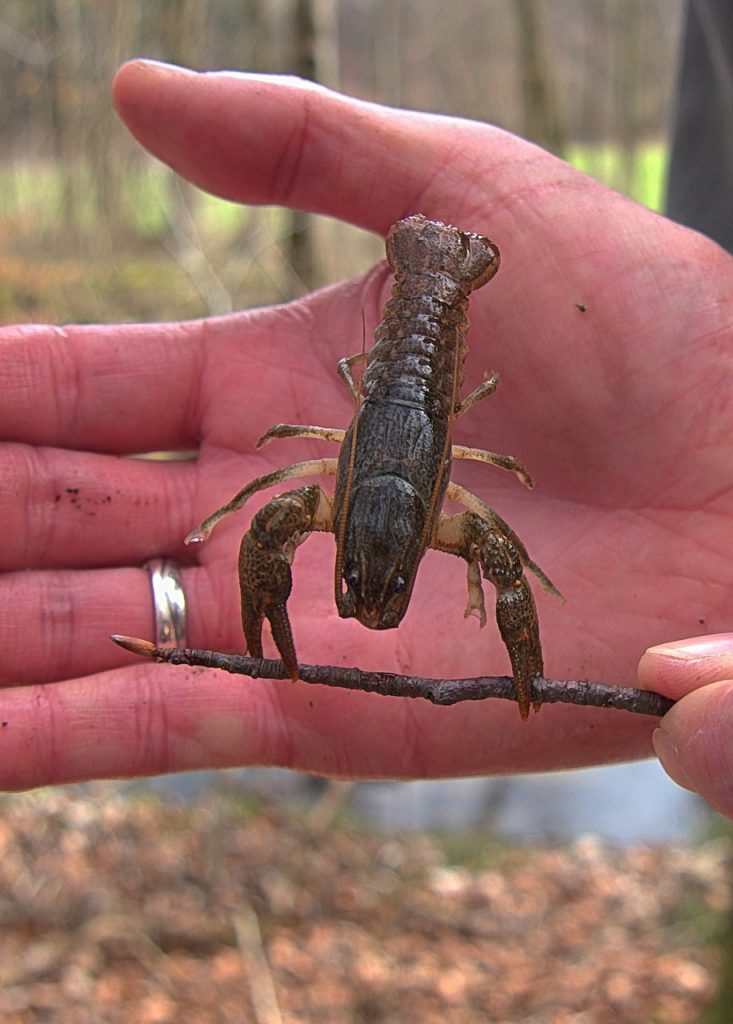If you're new here, you may want to subscribe to my RSS feed. Thanks for visiting!
By the author of The Prepper’s Guide to Post-Disaster Communications and The Cartoon Ham Exam Handbook: A Complete Ham Radio Technician License Study Guide
Did you know that you can use crawdads as a survival tool?
No, I’m not talking about using a crawdad as a mallet to pound your tent stakes in. What I’m talking about here is that the humble crawdad – one of my favorite little aquatic bug-thingies – can be incredibly useful when it comes to survival.
Let’s take a look as to why.

Crawdads are indicative of pollution levels.
I first became aware of this after reading something by Creek Stewart of “Fat Guys in the Woods” fame (could something with that title be aired today?).
One of the things that I’ve noticed about people with water filters is that until they go out and actually use them, they tend to be very hesitant to actually trust them. Sure, they have them and “know” that they filter out XYZ, but there’s a big difference between knowing something and using the information.
Despite how a lot of filters out there can keep you from drinking all kinds of nasty stuff, I still don’t willfully go out there looking for the most disgusting water source I can find to try to drink out of. While a lot of filters will keep out bacteria, protozoa, and sometimes viruses, depending on what you’re using, it may not be as good at keeping you from drinking chemicals.
This is an area where crawdads come into play.
Granted, if you’re in an area where crawdads live, odds are you’re in the wild, and there are not a lot of people around – so pollution shouldn’t be too big of an issue – but, hey, you never really know what’s going on upstream.
Crawdads can help.
To start, we know that the less dissolved oxygen there is in a body of water, the more polluted the water is. Poop, crop wastewater, and industrial waste that finds its way into the water supply are all directly correlated with a significant drop in dissolved oxygen.
And this is a problem for aquatic life. Fish, plants, certain bugs, and even crawdads all need that dissolved oxygen to live.
When crawdads find themselves in water with a low dissolved oxygen content, they do one of two things: they either try to leave the water, climbing up on shore, or they die. Those are their two options.
So in a way, you can use crawdads as at least some level of indication that the water you are about to use your purification process on isn’t heavily contaminated with a lot of disease-causing chemical nonsense.
Most certainly you’re still going to want to either boil or filter that water in some way to make it safe to drink. But you should be able to rest, perhaps, a bit easier knowing that you’re not harvesting water from an absolutely disgusting source.
Crawdads are food
At least where I live, it’s not uncommon at all for boys to spend the morning catching crawdads with their fingers and then cutting open a soda can to boil them all over a fire. There’s not a lot of food value this way – their butts are teeny – but there is some.
If you were going to rely on crawdads for food in a survival situation, my advice would be to use some passive means of collection. If you spend three hours bent over staring at the water and lifting heavy river rocks, you’re going to have spent a lot more calories than what it is that you’ve collected (not to mention your poor back).
I learned this from crab fishing. The best method is to use some type of trap with a bit of meat used for bait and then to wait.
As we noted in the Aesop’s Fables post, with survival, you have to have laser beam focus. Get one task done and then move on to the next. If you can get things that do work for you while you focus on other tasks, I think that’s the notion of a “force multiplier” applied to surviving. Build that trap with a little bit of dead fish thrown in it that you found, and let it sit while you improve the roof of your bushcraft shelter.
We typically always build our traps by cutting a water bottle in half and then stuffing the top into the base so that they can crawl in but can’t crawl out.
Come back three hours later and see what you’ve got.
Where I’m at, you’ll probably have four. Not a lot, but that’s four crawdads you just caught without any effort and would probably be about 50-75 calories depending on the size of them all. You have to collect a lot of wild plantain to get 50-75 calories.
They’re so good, they’ll make you sing.
So I wouldn’t use rely on crawdads as my primary food source necessarily, but they are definitely a nice one to also collect while you also catch fish, eat what’s in your bag, forage, and so on.
What do you think? Is there more to add to the story here? Do you eat crawdads? Do you have any crawdid tips for us? Let us know in the comment section.
About Aden
Aden Tate is a regular contributor to TheOrganicPrepper.com and TheFrugalite.com. Aden runs a micro-farm where he raises dairy goats, a pig, honeybees, meat chickens, laying chickens, tomatoes, mushrooms, and greens. Aden has four published books, What School Should Have Taught You, The Faithful Prepper, An Arm and a Leg, The Prepper’s Guide to Post-Disaster Communications, and Zombie Choices. You can find his podcast The Last American on Preppers’ Broadcasting Network.


















28 Responses
Check out this podcast interview of Sam Thayer on the WildFed podcast with host Daniel Vitalis. They get into crawdaddies/crayfish–catching them & cooking them.
Herbicide, Habitat & Edibility with Sam Thayer — WildFed Podcast #147
https://www.wild-fed.com/podcast/147
Louis
Looks like I’m starving to death! 🙂
You like shrimp? Lobster?
They are just smaller, freshwater versions. I think they are even sweeter.
Never had one till I was down in New Orleans. Just like anything, try them once.
Down in the deep south, with some wadders on, guys would push a net through the mud, strain, and come up with a few hundred crayfish at a time. They could easily fill a large cooler. That could be a meal for three or four people.
Of course you have to know how to twist the head off, and pinch the tail. Once you master that, it is real easy meal.
Uh, yeah…you lost me on the last sentence! 🙂 Like I’ve said before, I’m in trouble when SHTF.
Does not matter how you catch them or cook them. I won’t eat them. I went to a lot of social gatherings in South Texas that had lots of crawdads on the menu and they really knew how to cook them. I ate the corn and potatoes but not the mud bugs.
Crawdads are pretty much only for desperados. Not much meat. Requires heavy seasoning (shrimp sauce). My buddy, a great baseball player, drowned in a pond looking for crawdads. It was a community tragedy. I can see eating them as an emergency measure. Their meat can also be used as bait. By the way, they can pinch! My next door neighbor kept one in a hole in his yard as a pet for years. Have a happy day!
We have two types of crayfish (as we call them up North).
In the brook, hardshell crayfish. As the water runs fast, the hardshells fare better than softshell. I see them a few times a year, or after a fight (they fight to the death) the losers remains.
I stocked the big pond with about 100 crayfish. Then the following year, we had a drought that turned big pond into two big puddles. I am sure some have survived, but I have not seen any.
A few years ago I did find a large hardshell in the small drainage ditch. I picked it up, and put it in the big pond.
Crawdads aren’t native to Colorado. There are small populations in several of the Lakes and Reservoirs in the State. They are thought to have been introduced by anglers in the last 50 to 75 years. One species, the Rusty Crawdad is considered a serious environmental invasive species, and it is illegal to return them to the water. It’s also illegal to transfer any Live Bait West of the Continental Divide, and has been for as long as I can remember.
I do have a funny story to share. When we lived in town, there was a small lake at a nearby park, where kids could fish for Bluegills (though there were more Carp than Bluegill’s in the lake. My oldest son used to go there and fish whenever he had the chance. One day he discovered a bunch of Crawdads, and caught them and put them in his creel. He came home, and put his creel down and promptly forgot about them, and that they were still alive. They escaped, and we spent the next week tracking down dead and dying Crawdads, which crawled into every nook and cranny the could find. At the time we were livid, but 25 years later we can laugh about it.
Moral of the story, is don’t bring anything home alive that could get loose.
If you want to get all the nutritional value you “pinch tail and suck head” as I was told by my Cajun friends , there is ” fat under that carapace ( or head ,as you call it)” . There is more good flavor in that head also.
It is making me salivate just thinking about it.
Also don’t forget about the claw meat….. !
I live in southeast Texas and they live in some wet yards down here under the ground. You can find them by their little mud stacks in the yard. There are also farms that raise them. Same in Louisiana. We call them Crawfish and they get much bigger and are a much loved food in season.
No. Just, NO. I won’t eat anything with an exoskeleton. They’re marine bugs. I call shrimp the “cockroaches of the ocean” with their wiggly little legs and antennae… Getting nauseated just thinking about it.
You eat chicken? Turkey?
They are two legged, feathered, land faring cockroaches. Worms, bugs, sometimes their own eggs and shells.
Catfish? Bottom feeders.
Dang near every freshwater fish eats mosquito larvae.
I’m with Lorraine! I am totally grossed out by bugs of the sea/river. ????
Amen.
When I was growing up. My dad used to rake them out of the river banks and we used them for bait! So there is another way, catfish and bass provide much more food than a crawdad tail.
Have you ever fished using a crawdad or live shrimp?
Two days fishing in FL, using live shrimp.
I got one 5inch whiting. The fish and crabs got the rest.
BTW, what is the difference between getting live bait shrimp from a bait shop, and shrimp in the grocery store: The bait shop they are still alive, the grocery store, they have been killed, and maybe processed of removed the head, devein, shell on/off.
Otherwise, there is no difference.
MJH-I’m chuckling here, you’re my Marine fam & deeply respect you & your opinions so I am enjoying you trying so hard to convince us to eat crawfish! 😉
I’m picturing me talking you into eating one of my ‘kitchen sink’ deep green smoothies. Probably with the same reaction! Lol.
LOL!
Thank you Jennifo!
I’m from (and still live in the deep south) in Louisiana. Crawfish season, down here, is something we celebrate and look forward to! I guess it’s a cultural thing, but also a great excuse for folks to get together, socialize, and eat together! My husband has set out small crawfish traps in our pond, and our neighbor’s pond, and used them as bait. The bass, in our pond, loved them! Provided us a nice meal!
Louisianians are used to eating all kinds of things considered to be “normal” cuisine here, harvested from the land…crawfish, shrimp, crabs, alligator, turtle, squirrel, quail, mallard ducks, alligator gar, deer, frog legs, wild hogs, and an assortment of fresh and saltwater fish are most common, but some also eat nutria, raccoon, and snake (among other things that I probably left out!) They’re all so yummy if they are cooked right!
Grew up with the Aussie freshwater version – yabbies. I was never good at catching them, but my brothers caught bucketfuls.
Daisy – loved your Frugalite interview with Mike Adams today!!
Oh thank you! I’m so glad you liked it!
Absolutely!!!
Great interview!!!
Hope that can happen again n again!!
You both are awesome!!
Love boiled crawdads with plenty of Cajun seasoning. I trap mine while fishing. I bought 2 crawdad traps at a Walmart near a lake where I was camping on a week long fishing trip. About $12 each. Nice sturdy black metal traps. The first 3 hours we had them in the water with catfish guts we caught 49 crawdads! It was a grand start on lunch for 5 that day. I gave my son one trap and kept one.
I have plans for catching more this summer but for a different use. I plan to try raising crawdads and using rain water in an aquaponics set up. Lengths of PVC pipe and rocks will be cut as hiding spots for them.
My wife says as kids they used to catch crawdads with a little bit of bacon tied on a string.
We have family who live in Louisiana. While visiting once we were taken to a small restaurant/tavern to have some crayfish as they call them. We got half an order that was plenty for two with the potatoes & corn on the cob. My wife’s uncle showed us how to get the meat from the tail. I wasn’t very fast doing that so he started shelling them for us. I like shrimp so I didn’t have a problem trying the crayfish. I actually liked them.
The people native to that area suck the stuff from the heads too. ???????? That’s a bit too much for me. I didn’t try that!
You can use crawdads in a dried dug well , they will dig down to find water and replenish the water. Saw it happen over night.
“you never really know what’s going on upstream.” Unless you own a watershed. We looked a long time to find a circumferential hill, and bought the surrounding properties to get the creeks it feeds. It could be said that our neighbors down stream are using our ditch water.
One of the best uses is for bait. the soft ones(those that have recently shedded their shell) are the best. Great for bass, trout and catfish. the small hard ones, you just crush them a bit to release their odor into the water you are fishing.
they are not kosher, not food, sea roaches, if you want to eat bugs, go ahead. Not kosher, not me.